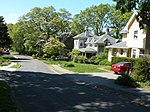Ginn Carriage House
Carriage houses in the United StatesCarriage houses on the National Register of Historic PlacesHouses in Winchester, MassachusettsNational Register of Historic Places in Winchester, MassachusettsTransportation buildings and structures on the National Register of Historic Places in Massachusetts ... and 1 more
Winchester, Massachusetts Registered Historic Place stubs

The Ginn Carriage House is a historic carriage house in Winchester, Massachusetts. The building, which has been converted to a residence, is one of two surviving outbuildings (the other is the gardener's house) of the extensive "Terrace of Oaks" estate of publisher Edwin Ginn, whose main house was demolished in 1946. The U-shaped brick carriage house, built in 1900, exhibits high quality construction details, and has touches of Georgian Revival styling. The original doors to the carriage area are still attached to the building, sheltered by a copper shed roof.The building was listed on the National Register of Historic Places in 1989.
Excerpt from the Wikipedia article Ginn Carriage House (License: CC BY-SA 3.0, Authors, Images).Ginn Carriage House
Ginn Road,
Geographical coordinates (GPS) Address Nearby Places Show on map
Geographical coordinates (GPS)
| Latitude | Longitude |
|---|---|
| N 42.446666666667 ° | E -71.141111111111 ° |
Address
Ginn Road 23
01890
Massachusetts, United States
Open on Google Maps











